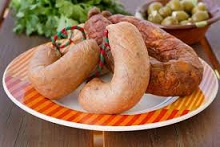The Hawaiian Portuguese Sausage is a popular and favorite food product. To find out about this delightful Portuguese treat, read our guide for more facts & information…
Hawaiian Portuguese Sausages are a favorite part of breakfast menus in Hawaii. Usually served with eggs and rice, the Hawaiian Linguica (which is the Portuguese word for the sausage) is so popular in the islands that it has replaced the famous bacon in the regular breakfast menu of a world renowned fast food chain.
Bring Home the Sausage
The word sausage is derived from the Latin word ‘salsus’ which means salted. Originally, makers of sausages used edible animal scraps such as liver, blood, and fat, salt, and spices as main ingredients stuffing the mixture into casings that are actually cleaned animal intestines or stomach sacs. Hawaiian Portuguese sausages are much more modern and contemporary however. Common sausage main fillings today are pork meat, beef, veal, or chicken. The Portuguese variant is a pork mixture.
No one knows the true origin of sausages but evidences in literature show that this food product was made and eaten by people even in ancient times. Chinese writings show that sausages or at least a Chinese variation was already around as early as 589BC. In the Greek novel ‘The Odyssey,’ a kind of blood sausage was mentioned while Epicharmus, a Greek dramatist and Philosopher wrote a comedy titled ‘The Sausage.’
Linguica: Portuguese Delicacy
The Linguica, like the Hawaiian variation is made of cured ground pork butt, meat, salt, and other spices including pepper, paprika, and garlic. Outside of Portugal, this Portuguese delicacy is also very popular in some states in the U.S. including Hawaii, Goa, which is a former Portuguese colony in India, Brazil, and Okinawa. In these places, it is also known simply as ‘Portuguese Sausage’ and is generally served as part of a meal.
Portuguese Sausages – Hawaiian Delight
It is said that the Linguica was brought to Hawaii by Portuguese immigrants who came to work in sugar plantations in the islands in the late 1800’s. The Hawaiian Linguica is a bit sweeter, larger, and softer than its authentic Portuguese counterpart, and is available in both original and spicy flavors. The Hawaiian Linguica is not only eaten as a part of a meal but is also used as an ingredient for other dishes. A local food chain for instance serves on its menu a breakfast sandwich of chopped linguica with cheddar cheese and scrambled eggs. It is also a main ingredient for a popular island recipe – the Portuguese bean soup or used as a sauce ingredient for some dishes.





